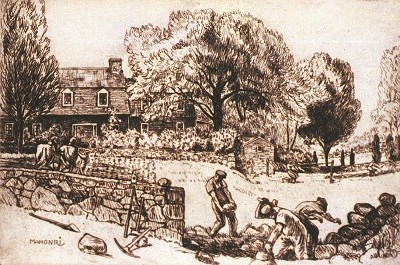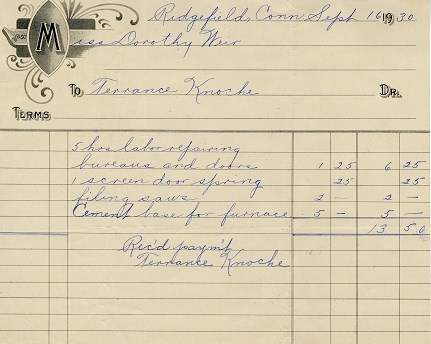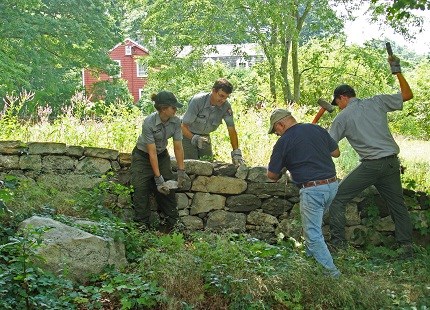Last updated: June 4, 2021
Article
The Knoche Family, Builders of Stonewalls for Weir Farm
By Dr. Darla Shaw, Volunteer Researcher
When Julian Alden Weir and his family moved to their Ridgefield farm there was only one neighbor. This neighbor was Joe Knoche, Sr., a German immigrant who had come to the United States when he was 14 years old. Old Joe, as he came to be called, was an extremely hard worker who was a master of construction, especially in regard to stonewall building and housing.
Old Joe began in the coal/ice business in New York City with his father. One day he decided to take a train ride to the country and did so with his big, mastiff dog. When he got to Branchville, CT, Joe decided to get off the train and walk around. He really liked the area and decided to stay, first on Barry Avenue. Later he purchased twenty eight acres on Pelham Lane, where his family still lives today in 2020.

National Park Service, Weir Farm National Historical Park, Wilton, CT. WEFA 501.
No one knows how Old Joe acquired his unique stonewall building skills. For his walls, Old Joe never used any plans or cement, but chiseled pieces of stone until they perfectly fit each area. Old Joe’s walls were a true work of art. The best examples of his work surround Weir Farm and are called the Great Walls of Cora. These walls received this title after Cora Weir Burlingham commissioned Old Joe to build almost a mile of walls for the farm.
Old Joe also produced beautifully orchestrated walls in the Ridgebury area, on Barry Avenue and for the Doubleday Estates. Evidence of his work can be seen in the unfinished foundation at the intersection of Nod Hill and Old Branchville Road. The structure above the foundation was never finished and now the foundation and land belong to the town of Ridgefield.

National Park Service, Weir Farm National Historical Park, Wilton, CT. WEFA 6587.
At one time Old Joe had many men working for him, but none of them could work as hard and be as detailed as he was as a mason. Because of this Old Joe decided to be a one man operation. Since Old Joe never got a license he had to be driven to all his jobs.
Since Old Joe found that he had trouble collecting money from some of his customers, he used a unique trick. When building a fireplace, he would put a glass shield over the top so the room would be smoky. If the family did not pay up, he would leave the glass there until they did. Once paid he would break the glass and all was fine.
Old Joe would also get extremely upset when he found “rock robbers” stealing some of the prize stones. He kept a close watch on his walls and also kept a menacing dog, named Punch, to deter these robbers. Almost all of the stones in Old Joe’s walls, came locally from the farm. A few special stones came from a quarry on Branchville Rd.
Old Joe met his wife, Mary Teresa Hickey, while working at Weir Farm. Mary was a laundress who had immigrated from Ireland. The couple were married in 1905 in New York City. Over the years Old Joe and Mary had four children. Joe, Junior, known as Young Joe was a skilled carpenter. His brother, Terrance, was also good at carpentry. There was also Elizabeth who became a nun and her sister, Teresa Mary. Old Joe made certain that all of his children went to college.

Brigham Young University Museum of Art, purchase/gift of the Mahonri M. Young Estate, 1959
Although Old Joe was responsible for the stone work on Weir Farm, his two sons were later responsible for construction projects at Cora Burlingham’s house and the Weir Farm house. The Knoche family always watched over the Weir House and were very protective of the farm, especially when the Weir family was not there.
The Weirs, and the Knoche family had a good relationship based on respect. Both families were also friendly with the Bass family that worked the farm. The Knoche and Bass children appreciated that they were freely allowed to use the property, unless a social engagement was going on. They also liked being able to pick the farm’s fruits and vegetables and take them home.
There are several sketches of Old Joe working on his precious walls by various artists that visited the farm. Dorothy Weir Young also created two paintings of Teresa that are now a part of the Brigham Young University Museum collection in Salt Lake City, Utah. One is of Teresa in a blue dress and the other is of Teresa with her cat, Tommy on her lap.
A Knoche tradition started by Young Joe was a visitation to the old Beer’s Cemetery, near Weir Farm, on Memorial Day. The family would put flowers on the graves of the veterans. The Knoches were a proud, united, close knit family that believed in serving others.

NPS Photo
As of 2020 Old Joe and his wife Mary had three remaining children. Young Joe died recently, leaving a wife Peg and a son, Joe III. Teresa married Joe Sheehy and had three children, Joseph, Mary Carty, and Elizabeth. There are now also great grandchildren, most of which have visited Weir Farm. Weir Farm is most proud of the fact, that the Knoche grandchildren and great grandchildren not only visit the farm, but serve as volunteers. One even served as a park ranger on the farm.
The Knoche family is, "as Weir Farm as you can get." They loved their jobs on the farm. They loved the land and the people that lived, worked and were artists there. The Knoche family considers Old Joe one of Weir’s artists. His artist’s tools were his star drills, hammers and chisels. His stone walls will always stand as a testament to his art. The park now pays tribute to Old Joe’s work by giving stonewall tours.
At one time the town suggested that Pelham Lane be called Knoche Lane. The family did not think that was necessary. They were just happy to live where they had made a difference and were remembered.
